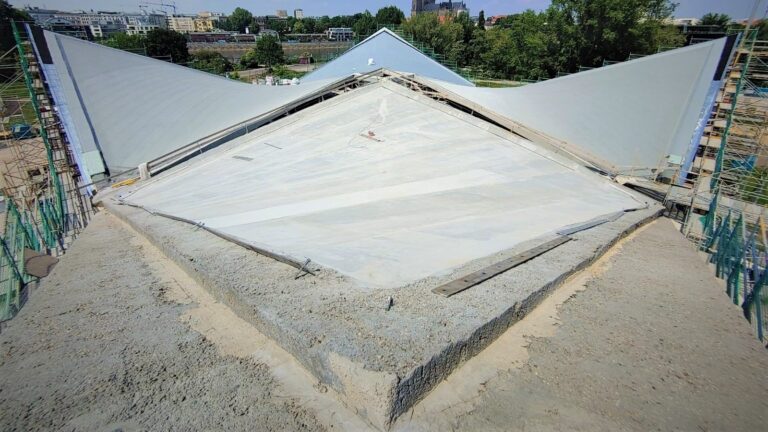
Continuous Timber Beam
HTM+
DLT+The HTM+ program is used to calculate single-span and multi-span timber beams. A cantilever beam is selectable as a special case. Cross-sections can be defined with a haunch, with joints or with a reinforcement, also multi-part cross-sections are possible. In addition to all the verifications required by the relevant standards, also a hot design and a vibration analysis can be performed. As an additional option, biaxial loading is selectable.
Discover now more programs from the section Timber & Roof!
SHOW MOREMaterial
- Softwood of the strength classes C14 to C50
- Hardwood of the strength classes D18 to D80
- Glulam of the strength classes GL20c to GL32c
- Glulam of the strength classes GL20h to GL32h
- Laminated veneer lumber LVL 22C – 80P
- STEICO LVL R, LVL Rs, LVL RL, LVL X
Structural system
- Single-span or multi-span beam with or without cantilevers
- Different cross-sections for each span or section
- Any type of haunched beam
- Multi-part beams
- Rotation of the beam is possible
- Definition of joints in the system
- Lateral restraints are adjustable
- Selection of the lamellae’s fibre orientation for glulam and laminated veneer lumber (edgewise/flatwise)
Loads
- Vertical and horizontal loads resulting from linear, concentrated, moment, triangular, and trapezoidal loads
- Self-weight can be considered automatically
- Each load can be defined individually for the spans
- Consideration of a beam spacing with automatic conversion into area loads
- Definition of concurrency and alternative groups
- User-defined actions with freely selectable partial safety factors
- With biaxial loading, the user can freely define the angle between 0° and 90°
- Import of loads from the LAST+ program
Cross-sections
- Freely selectable width and height
- Default preferable cross-sections for each material
- Storage of user-defined cross-sections in the database
- Definition of lateral timber reinforcements with variable dimensions and materials
- Definition of lateral steel reinforcements (for example U-sections)
Structural safety
In the design as per EN 1995, the persistent, transient, accidental, quasi-permanent, and characteristic design situations in accordance with EN 1990 are considered. The verifications for bending, shear and bearing stress are performed. Moisture action is considered via the usage class. The user can select the transverse pressure coefficient kc90.
Optionally, a hot design can be performed with the ideal residual cross-section. The user can select whether the verification should be based on the simplified or the accurate method in accordance with DIN EN 1995. The charring rates can be considered according to the standard or self-defined. Fire exposure and the fire resistance class can be varied.
Instead of a continuous restraint, the position of restraints in the longitudinal direction of the beam and on the cross-section can be defined. Subsequently, the beam is checked for lateral torsional buckling of bending members in accordance with DIN EN 1995-1-1. If this stability verification becomes decisive, the program puts it out in addition.
Serviceability
For the verification of the deformation, the limit values of the elastic deflection, of the sum of elastic deflection and creep deformation as well as of the final deformation can be defined separately for the span and the cantilever. Deformations from shear can optionally be considered in the calculation.
Optionally, the user can perform a vibration analysis as per DIN EN 1995-1-1 or in accordance with Hamm, P.; Richter, A.: Bemessungs- und Konstruktionsregeln zum Schwingungsnachweis von Holzdecken. In addition to the width of the ceiling span, the modal damping ratio can also be defined variably. Additional stiffness from the ceiling structure can also be considered.
Additional options
HTM-2: Biaxial Bending
With the help of this add-on, the user can define biaxial loading and perform the corresponding design. Each load can apply at an angle between 0° and 90°. The loads are automatically separated into a horizontal and a vertical load share. The user can define elastic supports, restraints in upright members and end restraints as well as column settlement in each direction separately. Joints function as bending joints about the y-axis as well as about the z-axis.
Document file formats
- Word
- Printer
Output
- brief
- detailed
- without design
- user-defined
Data transfer options
- Steel Column (support reactions) STS+
- Timber Column (support reactions) HO1+
- Reinforced Concrete Column (support reactions) B5+
- Timber Compression, Steel Plate (support reactions) TB-HHS
- Continuous Steel Beam (entire structural system) STM+
- Continuous Concrete Beam (entire structural system) BTM+
- Framework (entire structural system) RSX+
Load import
- Import of loads from the LAST+ program
Import options
- FRILO XML
- ASCII-file
Export options
- Word
- FRILO XML
Timber construction
- DIN EN 1995
- ÖNORM EN 1995
- NTC EN 1995
- BS EN 1995
- PN EN 1995
- EN 1995
News

“With the FRILO Suite, we benefit from the use of all programs”
With the switch to the FRILO Suite, the engineering office concon has decided to rely on the FRILO subscription model. The reasons of the long-standing customer are manifold.

FRILO & CARBOrefit® | The calculation with carbon concrete pays off
With CARBOrefit® an process that enables renovation and reinforcement with carbon concrete has been integrated into the FRILO Software.





